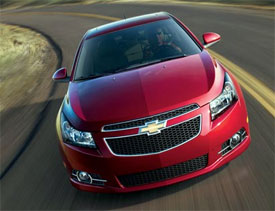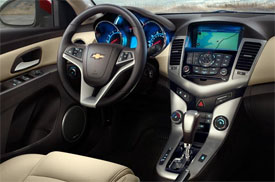2011 Chevrolet Cruze
For decades, Detroit’s automakers have been either unable or unwilling to sell world-class small cars in America. Too often their small cars were dumbed down to meet low cost and low expectations of a public that sees them only as basic transportation. Now, finally, we’re starting to see some of the great small cars Detroit builds for other countries come here. First it was the subcompact Ford Fiesta. And now it’s this car, the compact Chevrolet Cruze.
The 2011 Chevrolet Cruze is already sold in some 60 markets other than North America, where it plays the role not of commuter car, but of mainstream family sedan. So, while technically a compact, like the Cobalt before it, the Cruze is big for its ilk. At 181.0 inches in overall length, it’s six inches longer than a Toyota Corolla.
From its familiar two-tiered Chevy grille to its thickset back-end, the Cruze exudes a taut international profile and an overall look that’s substantial, but also very safe. Substantial too are Cruze wheels and tires with standard 16-inch and optional 17s and 18s.
The Cruze powertrain line-up will surprise many. Most trims are fitted with a trick 1.4-liter variable-timing, turbocharged I-4 rated at 138 horsepower and 148 pound-feet of torque. Only the base Cruze LS uses a non-turbo 1.8-liter ECOTEC with 138 horsepower and 123 pound-feet of torque.
 The LS and high mileage Cruze ECO models come with a standard six-speed manual, while others start and end with a six-speed manual-mode automatic.
The LS and high mileage Cruze ECO models come with a standard six-speed manual, while others start and end with a six-speed manual-mode automatic.
That provides Cruze with Government Fuel Economy ratings of 24 city/36 highway using regular gas. We saw a solid 31.5 in real-world driving. Cruze Energy Impact Score is a modest 12.2 barrels of oil consumed per year, with a smallish Carbon Footprint of 6.7 annual tons of CO2 emitted.
But hypermilers will be more interested in the Cruze ECO due later. With a slew of aero upgrades, it will bare a highway rating of 42, more than the smaller Ford Fiesta. There are even more surprises inside.
The interior of the Chevy Cruze is a real game changer. Not only is it very quiet, and near mid-size in roominess, the quality of materials is impressive. Instead of acres of hard plastics, you’ve got soft materials on the face of the dash and the doors. And over here, around the center console and the center stack, expensive-look ‘piano black’ accents. That’s not what I would expect to find in a moderately priced compact car.
This edition of Chevy’s cockpit interior theme is very handsome, although some felt slightly penned in by it. The easy scan motorcycle-like gauge cluster with trip computer screen fits well. Seats are comfortable, nicely bolstered, with good lower back support. Our 2LT trim added leather and heat. All Cruze models are well-equipped with air, six-speaker CD/XM-stereo, keyless entry, and lots of cupholders and storage options. And for safety, Cruze wears OnStar and an impressive 10 airbags, including two rear seat side bags.
The rear seat offers ample room for three, although leg room is less than we’d hoped. But fold the 60/40 seat backs and the trunk’s already huge 15 cubic feet of space grows exponentially. So it may be world-class in design, but does it drive that way too?
 With no notable turbo lag, initial throttle response is great. But, tall gearing bogs things down from there. Still, a 0-60 of 9.2 seconds is within expectations for an economy sedan. The quarter mile passed in a lazy 17.1 seconds at 82 miles per hour with mostly smooth shifts.
With no notable turbo lag, initial throttle response is great. But, tall gearing bogs things down from there. Still, a 0-60 of 9.2 seconds is within expectations for an economy sedan. The quarter mile passed in a lazy 17.1 seconds at 82 miles per hour with mostly smooth shifts.
High strength steel gives the Cruze a solid platform to mount a front strut, and rear torsion beam suspension. Engineers added a centering Watts Linkage, here called Z-Link, for added roll and lateral control. Traction and Stability Control are standard.
Surprise again, the Cruze scoots through the cones with the kind of agility you expect from a car designed for Europe and beyond. Understeer is moderate and consistent, with good steering feedback. The driver can actually concentrate on having a little fun. Overall, Cruze handling is safe and solid.
The Cruze is fitted with ABS front discs and rear drums standard, with all-disc an option. Our car’s disc/drum combo averaged an acceptable 129 feet from 60 to zero. Reaction was stable and the pedal reasonably firm. On normal roads, Cruze ride quality is also solid. It conveys the quietude of a premium-level vehicle. Cruze prices are higher than the outgoing Cobalt, but they’re still very reasonable. The Cruze LS starts at $16,995, the LT at $18,895, and the LTZ at $22,695.
The success of the 2011 Chevrolet Cruze is critical to GM’s long-term global prosperity. Fortunately, it beat all of our expectations, and then some. It’s a well-equipped, roomy, high quality, small car that should make even the most dyed-in-the-wool import buyers take a long and hard second look.
Specifications
- Engine: 1.4-Liter Variable-timing, Turbocharged I-4
- Horsepower: 138
- Torque: 148 Lb Feet
- 0-60 MPH: 9.2 Seconds
- 1/4 Mile: 17.1 Seconds @ 82 MPH
- 60-0 MPH: 129 Feet
- EPA: 24 MPG City/ 36 MPG Highway
- Mixed Loop: 31.5 MPG
- Energy Impact 12.2 Barrels Oil/Yr:
- CO2 Emissions: 6.7 Tons/Yr
2025 Volkswagen ID. Buzz
Volkswagen Brings Beetlemania Level Of Excitement To Minivan Segment
The duty of upholding Volkswagen’s heritage has most recently been delegated to small legacy car names like Golf and Jetta. But hold on! A much larger, totally modern take on VW’s classic microbus has just buzzed over the horizon— the all-electric ID. Buzz. It’s been at the top of our minds since we first saw the concept back in 2017. Well, it’s finally here, so let’s get our groove into drive!
This 2025 Volkswagen ID. Buzz has indeed created the most buzz around Volkswagen since the Beetle’s return to the U.S. in the late 1990s. We couldn’t drive it anywhere without drawing a crowd. No wonder, just about everyone has a VW Microbus story to tell, and seeing this reimagined version rolling down the street brings back all those memories.
VW really pulled it off as far as we’re concerned, as it looks great without appearing over the top. All the cues are here: Big VW logo front and center, lots of greenhouse including A-pillar windows and mini sliders for the second-row passengers, D-pillar air vents, and two-tone wheels. And while its appearance may be pure retro, its drivetrain is far from it, as the ID. Buzz is all-electric, and unlike the new Beetle, the Buzz does retain the original Microbus’ rear-drive architecture.
Powering those rear wheels is a 210-kW motor drawing juice from a 91-kWh battery for a range of 234 miles; 200-kW max charging will get you to 80% in about 26 minutes. Buyers can add another small 80-kW motor up front for 4motion all-wheel-drive and an increase of total output from 282 to 335 horsepower with a combined 512 lb-ft of torque. It uses the same battery, but range estimates drop just slightly to 231 miles. But while those numbers are modest, we also found them to be quite conservative, as we observed as many as 287 miles available in our all-wheel-drive tester’s gauge display and were on pace for 273 miles in our driving loop.
One throwback theme that may be a turnoff to some is that it’s quite a step up into the Buzz’s front seats, but there’s certainly a commanding view of the road once you climb in. Second row seating can be either a three-place bench or a pair of captain’s chairs, so there’s generous room for seven or six passengers. The captain’s chairs in our Pro S Plus offer good support and very easy access to the third row.
Lots of flexibility too with the option to simply fold the seats or remove them altogether.
With the sliding side doors and a wide opening rear hatch, there’s plenty of access for loading big sport utility amounts of cargo. Lots of flexibility too with the option to simply fold the seats or remove them altogether, and the ability to create a full-length flat floor with a rear cargo shelf that covers some handy removable storage bins. There’s 18.6 cubic-feet of space behind the third row, 75.5 behind the second, and a max of 145.5. That’s more than a Chevrolet Tahoe. For smaller items, there are lots of cubbies throughout the cabin, along with a standard Buzz Box that can be moved to multiple locations.
With a design that prioritizes retro form and modern function over aero efficiency, the 4motion equipped ID. Buzz earns a Fair efficiency rating, using 42-kWh of electricity per 100 miles, and we weren’t sure what to expect at our Mason Dixon test track.
What we found was great torque off the line and drama free launches to 60 in just 5.3 seconds. It was very stable at speed and power delivery stayed steady most of the way down the track until we reached about 90 mph, when it began to taper off just before we finished the quarter-mile in 14.0 seconds flat at 97 mph.
With 1,200-lbs. of battery weight nestled in its 127.5-inch wheelbase, the Buzz felt planted to the pavement through our handling course. There was quite a bit of body roll to deal with, but surprisingly little understeer. In panic braking runs, pedal response was inconsistent, feeling soft at times, pushing back hard at others; but through it all, results were quite good, stopping from 60 in an average of just 108 feet.
Three interior themes are available, this Dune is the brightest, featuring coastal inspired wood optic dash décor, “gray and clay” leatherette surfaces, and a high-mounted central 12.9-inch touchscreen. Pricing starts with a rear-wheel-drive Pro S at $61,545; this Pro S Plus begins at $65,045, add another $4,500 for 4motion, which brings a few extra features along with all-wheel drive.
Retro design with old-school VW charm, modern EV drivetrain, big SUV capacity merged with minivan flexibility; it all comes together in this 2025 Volkswagen ID. Buzz. It’s easily one of the coolest rides of the year and one that will likely keep Volkswagen dealers buzzing for years to come, and that’s something no other people and things mover can say.
Specifications
As Tested
- Motor Setup: Dual-Motor AWD
- Battery Size: 91-kWh
- Horsepower: 335
- Torque: 512 lb-ft
- EPA Range: 231 miles
- 0-60 mph: 5.3 seconds
- 1/4 Mile: 14.0 seconds at 97 mph
- Braking, 60-0: 108 feet
- MW Test Loop: ~ 273 miles













































